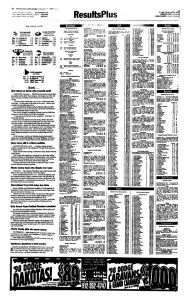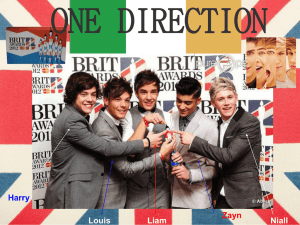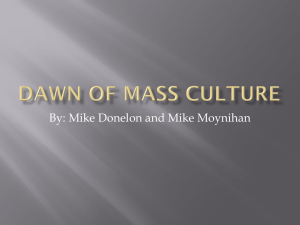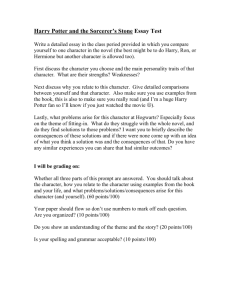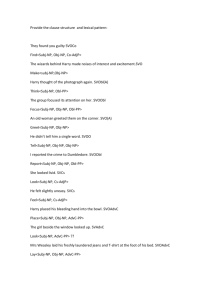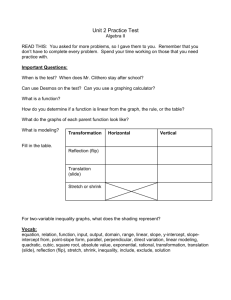A baseball broadcaster on radio and television. He covered four
advertisement
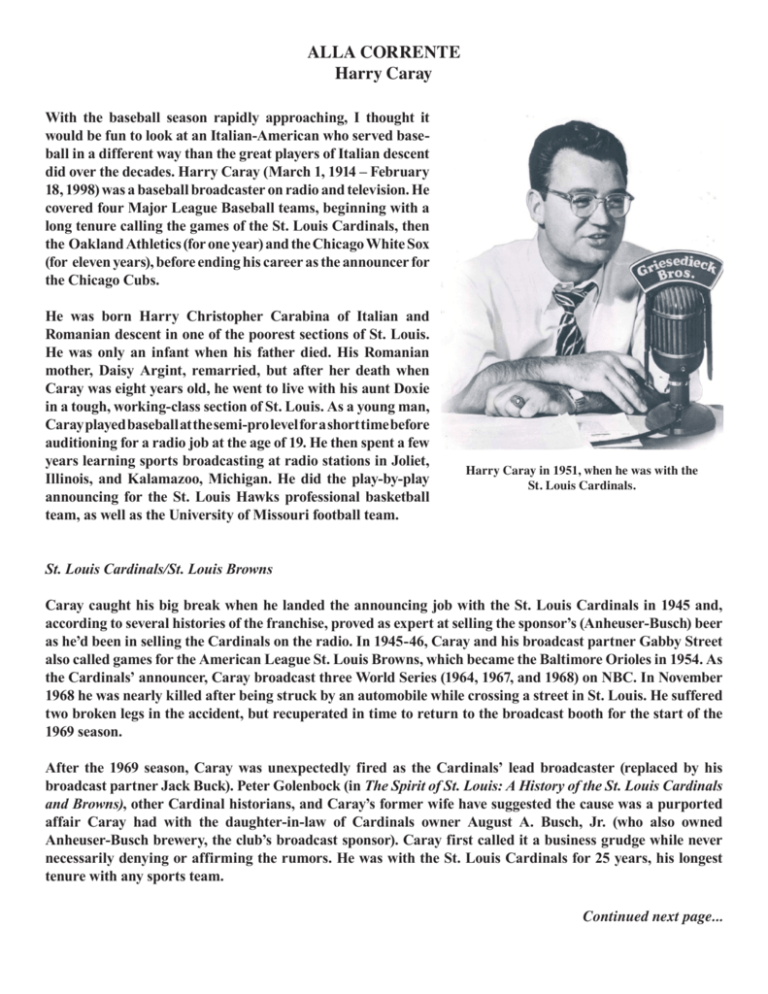
ALLA CORRENTE Harry Caray With the baseball season rapidly approaching, I thought it would be fun to look at an Italian-American who served baseball in a different way than the great players of Italian descent did over the decades. Harry Caray (March 1, 1914 – February 18, 1998) was a baseball broadcaster on radio and television. He covered four Major League Baseball teams, beginning with a long tenure calling the games of the St. Louis Cardinals, then the Oakland Athletics (for one year) and the Chicago White Sox (for eleven years), before ending his career as the announcer for the Chicago Cubs. He was born Harry Christopher Carabina of Italian and Romanian descent in one of the poorest sections of St. Louis. He was only an infant when his father died. His Romanian mother, Daisy Argint, remarried, but after her death when Caray was eight years old, he went to live with his aunt Doxie in a tough, working-class section of St. Louis. As a young man, Caray played baseball at the semi-pro level for a short time before auditioning for a radio job at the age of 19. He then spent a few years learning sports broadcasting at radio stations in Joliet, Illinois, and Kalamazoo, Michigan. He did the play-by-play announcing for the St. Louis Hawks professional basketball team, as well as the University of Missouri football team. Harry Caray in 1951, when he was with the St. Louis Cardinals. St. Louis Cardinals/St. Louis Browns Caray caught his big break when he landed the announcing job with the St. Louis Cardinals in 1945 and, according to several histories of the franchise, proved as expert at selling the sponsor’s (Anheuser-Busch) beer as he’d been in selling the Cardinals on the radio. In 1945-46, Caray and his broadcast partner Gabby Street also called games for the American League St. Louis Browns, which became the Baltimore Orioles in 1954. As the Cardinals’ announcer, Caray broadcast three World Series (1964, 1967, and 1968) on NBC. In November 1968 he was nearly killed after being struck by an automobile while crossing a street in St. Louis. He suffered two broken legs in the accident, but recuperated in time to return to the broadcast booth for the start of the 1969 season. After the 1969 season, Caray was unexpectedly fired as the Cardinals’ lead broadcaster (replaced by his broadcast partner Jack Buck). Peter Golenbock (in The Spirit of St. Louis: A History of the St. Louis Cardinals and Browns), other Cardinal historians, and Caray’s former wife have suggested the cause was a purported affair Caray had with the daughter-in-law of Cardinals owner August A. Busch, Jr. (who also owned Anheuser-Busch brewery, the club’s broadcast sponsor). Caray first called it a business grudge while never necessarily denying or affirming the rumors. He was with the St. Louis Cardinals for 25 years, his longest tenure with any sports team. Continued next page... ALLA CORRENTE, Continued Harry Caray Oakland Athletics He spent one season broadcasting for the Oakland Athletics before, as he often told interviewers, he grew tired of owner Charles O. Finley’s interference, and accepted a job with the Chicago White Sox. Among other things, Finley had wanted Caray to change his broadcast chant of “Holy Cow” to “Holy Mule.” (Recall that one of the A’s mascots while Finley owned the team was a mule). However, there were some reports that Caray and Finley did, in fact, work well with each other and that Caray’s strained relationship with the A’s came from longtime A’s announcer Monte Moore: Caray was loose and free-wheeling while Moore was more conservative. Chicago White Sox Caray joined the Chicago White Sox in 1971 and quickly became popular with the South Side faithful, enjoying a reputation for joviality and public carousing (sometimes doing home game broadcasts bare-chested from the bleachers). However, he wasn’t always popular with players. He had a reputation for being excessively critical of home team blunders and for continuing criticism of certain players after only one on-field mistake. In 1976, during a game against the Texas Rangers, Caray had former outfielder Jimmy Piersall (who was working for the Rangers at the time) as a guest in the White Sox booth that night. The tandem proved to work so well that Piersall was hired to be Caray’s partner in the White Sox radio and TV booth beginning in 1977. Piersall and Caray became a very popular announcing team. Among many of Caray’s experiences during this time with the White Sox, one incident was to define him to fans for the rest of his life. Disco Demolition Night on July 12, 1979 began as an effort to sell seats at a White Sox/Detroit Tigers double-header, but devolved into tens of thousands of eager fans storming onto the outfield at Comiskey Park in between the games of the double-header. Caray tried to calm the crowd by leading the park in the singing of “Take Me Out to the Ball Game,” but order could not be restored. Eventually the White Sox were forced to forfeit the second game of the double-header. This was a prelude to what would make history soon after. In the broadcast booth, Caray had often made a habit of privately singing along with the famous seventh-inning stretch song “Take Me Out to the Ball Game” while long-time Comiskey Park organist Nancy Faust was playing it for the public. One afternoon, he was singing to himself when WMAQ radio producer/broadcaster Jay Scott decided to open the booth mics without letting Caray know that he was doing this. (Some years before, Scott had suggested the idea in a memo, but Caray had rejected the idea). Once he realized that the home fans liked his leading them in singing the song, he relished the opportunity to continue doing so. For the rest of his career, Caray enthusiastically led the song’s singing during the seventh-inning stretch, using a hand-held microphone and holding it out outside the booth window. Continued next page... ALLA CORRENTE, Continued Harry Caray Many of these performances began with Caray speaking directly to the fans in attendance either about the state of the day’s game or about the Chicago weather while the park organist held the opening chord of the song. Then with his trademark opening, “All right! Lemme hear ya! Ah-One! Ah-Two! Ah-Three!” he would launch into his distinctive, down-tempo version of “Take Me Out to the Ball Game.” During his tenure announcing games at Comiskey Park and later Wrigley Field, he would often replace “Root, root, root for the home team” with “Root, root, root for the White Sox (or Cubbies).” For the lyrics, “One, two, three, strikes you’re out....” he would usually hold the microphone out to the crowd to punctuate the climactic end of the song. And if the visitors were ahead in that game, Caray would typically make a plea to the home team’s offense: “Let’s get some runs!” The seventh-inning stretch routine had become so popular over the years that after his death, the Cubs began a practice of inviting guest celebrities, either local or national, to lead the singing Caray-style. This practice of “guest conductors” continues to this day. During the 2009 NHL Winter Classic at Wrigley Field, as the Chicago Blackhawks hosted the Detroit Red Wings on New Year’s Day 2009 in the outdoor hockey game, former Blackhawks players Bobby Hull, Stan Mikita, and Denis Savard and former Cubs players Ryne Sandberg and Ferguson Jenkins sang a hockeythemed version of the seventh-inning stretch song: “Take Me Out to the Hockey Game” using lines such as “Root, root, root for the Blackhawks” and “One, two, three pucks, you’re out.” The Blackhawks would do this again in 2010 during the White Sox–Cubs game at Wrigley Field. This time it was as members of the 2010 Stanley Cup Champion team that did the singing to the delight of fans of both Chicago baseball teams. Caray was known for his unabashed homerism (i.e. his strong support for the “home team.”) While advertisers played up his habit of openly rooting for the Cubs from the booth (for example, one Budweiser ad described him as “Cub Fan, Bud Man” in a Blues Brothers-style parody of “Soul Man”), he had been even more aggressive about rooting for the Cardinals when he had broadcast for them. He said later that his firing from the Cardinals changed his outlook and made him realize that his passion was for the game itself, and especially for the fans, more than anything else. Another trademark expression of Caray was his frequent exclamation of “Holy Cow!” As he noted in interviews and in his autobiography Holy Cow!, he trained himself to use this expression in order to avoid any chance of using profanity on the air. He also avoided any risk of mis-calling a home run, using yet another trademark call: “It might be . . . it could be . . . it IS! A home run! Holy cow!” In Holy Cow!, Caray said he first used the “It might be...” part of that expression on the air while covering a college baseball tournament in Kalamazoo, Michigan in the early 1940s. He also said that was probably the first time he said “Holy cow!” on the air. In 1987, the Cubs had Ryne Sandberg, Jim Sundberg, and Scott Sanderson on the roster. Caray had suffered a stroke in February and often confused these names; it was not uncommon for him to refer to “Jim Sandberg”, “Ryne Sanderson,” “Ryne Sandbag” or “Scott Sundberg”. He also once pronounced pitcher Jason Isringhausen as “Jason....Ice-ring-hoisen.” He was intrigued by unusual names, and one of his frequent on-air bits was to try to pronounce a multi-syllabic name backwards. This bit became more challenging for him in the 1987 season after his stroke, but he kept trying and even poked fun at himself when he got it wrong. Two player Continued next page... ALLA CORRENTE, Continued Harry Caray names he took delight in pronouncing backwards were Toby Harrah and James ‘Truck’ Hannah. Even short names sometimes amused him: once, when Manny Mota had just lined out to a Cardinals fielder who did not even need to move his feet to make the catch, he announced: “ ‘Mota’ spelled backwards is ‘atom’ ... and that’s where he hit it, right at ‘im!” Caray had a reputation for mastering all aspects of broadcasting: writing his own copy, conducting news interviews, writing and presenting editorials, covering other sports such as University of Missouri football, and hosting a sports talk program. He was considered a fan’s broadcaster above all else, like such announcers as New York/San Francisco Giants legend Russ Hodges or Pittsburgh Pirates legend Bob Prince. This did not always earn him respect to equal his popularity. However, he never pretended to be the kind of objective announcer that broadcasters like Red Barber and Vin Scully prided themselves on being, regardless of their team attachments. Caray maintained a winter home in Palm Springs, California, along with his primary residence in Chicago. He was at a Rancho Mirage restaurant on February 14, 1998, celebrating Valentine’s Day with his wife Dutchie, when he collapsed, and in the process allegedly hit his head on the side of a restaurant table. He was rushed to nearby Eisenhower Medical Center where he never regained consciousness, dying of cardiac arrest with resulting brain damage four days later. His funeral took place in downtown Chicago’s Holy Name Cathedral on February 27, two days before he would have turned 84. Many celebrities and athletes were in attendance, including Sammy Sosa and former Chicago Bears head coach Mike Ditka. At his funeral, the organist played “Take Me Out to the Ball Game.” He was interred in All Saints Cemetery in Des Plaines, Illinois. Honors and Legacy In 1989, the Baseball Hall of Fame presented Caray with the Ford C. Frick Award for “major contributions to baseball.” That same year, he was inducted into the American Sportscasters Association Hall of Fame. He also has his own star on the St. Louis Walk of Fame. On June 24, 1994, the Chicago Cubs had a special day honoring Harry for 50 years of broadcasting Major League Baseball. Sponsored by the Cubs and Kemper Insurance, pins were given out to some unknown number of fans in attendance that day. The pins had a picture of Harry, with writing saying “HARRY CARAY, 50 YEARS BROADCASTING, Kemper MUTUAL FUNDS” and “HOLY COW”. In 1994, Caray was the radio inductee into the NAB Broadcasting Hall of Fame. On October 23, 1987 Harry Caray’s Italian Steakhouse opened in the Chicago Varnish Company Building, a Chicago Landmark building that is also listed on the National Register of Historic Places. There are now six restaurants, and an off-premise catering division which bear the Harry Caray name. The original restaurant has received numerous awards for its food and service, and features many items of memorabilia, even a statue of a “Holey Cow” (complete with holes) wearing the trademark Harry Caray eyeglasses. -Dr. James J. Boitano Adapted from Wikipedia
